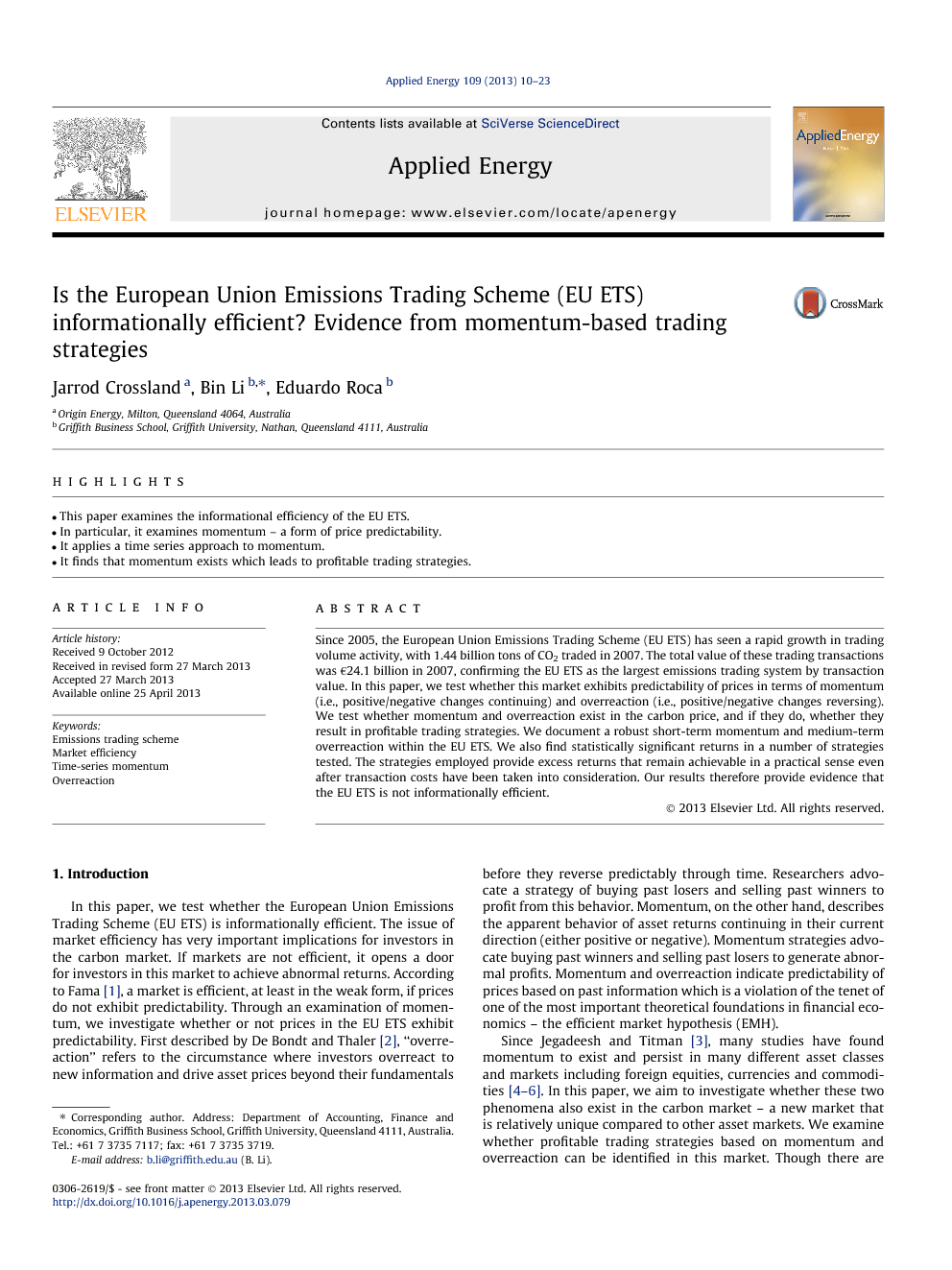Since 2005, the European Union Emissions Trading Scheme (EU ETS) has seen a rapid growth in trading volume activity, with 1.44 billion tons of CO2 traded in 2007. The total value of these trading transactions was €24.1 billion in 2007, confirming the EU ETS as the largest emissions trading system by transaction value. In this paper, we test whether this market exhibits predictability of prices in terms of momentum (i.e., positive/negative changes continuing) and overreaction (i.e., positive/negative changes reversing). We test whether momentum and overreaction exist in the carbon price, and if they do, whether they result in profitable trading strategies. We document a robust short-term momentum and medium-term overreaction within the EU ETS. We also find statistically significant returns in a number of strategies tested. The strategies employed provide excess returns that remain achievable in a practical sense even after transaction costs have been taken into consideration. Our results therefore provide evidence that the EU ETS is not informationally efficient.
In this paper, we test whether the European Union Emissions Trading Scheme (EU ETS) is informationally efficient. The issue of market efficiency has very important implications for investors in the carbon market. If markets are not efficient, it opens a door for investors in this market to achieve abnormal returns. According to Fama [1], a market is efficient, at least in the weak form, if prices do not exhibit predictability. Through an examination of momentum, we investigate whether or not prices in the EU ETS exhibit predictability. First described by De Bondt and Thaler [2], “overreaction” refers to the circumstance where investors overreact to new information and drive asset prices beyond their fundamentals before they reverse predictably through time. Researchers advocate a strategy of buying past losers and selling past winners to profit from this behavior. Momentum, on the other hand, describes the apparent behavior of asset returns continuing in their current direction (either positive or negative). Momentum strategies advocate buying past winners and selling past losers to generate abnormal profits. Momentum and overreaction indicate predictability of prices based on past information which is a violation of the tenet of one of the most important theoretical foundations in financial economics – the efficient market hypothesis (EMH).
Since Jegadeesh and Titman [3], many studies have found momentum to exist and persist in many different asset classes and markets including foreign equities, currencies and commodities [4], [5] and [6]. In this paper, we aim to investigate whether these two phenomena also exist in the carbon market – a new market that is relatively unique compared to other asset markets. We examine whether profitable trading strategies based on momentum and overreaction can be identified in this market. Though there are studies relating to market efficiency in the carbon market, to the best of our knowledge, our paper is the first to investigate momentum and overreaction within the market.
We undertake our investigation of momentum and overreaction with respect to the EU ETS. The EU ETS is the most mature CO2 emission-trading market and largest market for emissions trading, accounting for more than 90% of the world’s transaction volume and value for CO2 allowances [7]. However, it is only in its 8th year having commenced only on January 1st, 2005 with all 15 then members of the European Union participating. The first phase (Phase I) of the EU ETS – regarded as a trial period – ran from 2005 to 2007 covering more than 12,000 installations responsible for approximately 40% of the European Union’s CO2 emissions. The second phase (Phase II) of the EU ETS covers the period from the beginning of 2008 to the end of 2012 with all 27 current member states participating.
Since the commencement of the EU ETS in 2005, the market has seen dramatic growth in both the volume of EU Emission Allowances (EUAs) permits traded and the value of transactions. Table 1 shows the evolution and growth of this emerging market, where the volume and value of transactions have increased greater than ten times from 2005 to 2009, although the growth from 2008 to 2009, corresponding to the Global Financial Crisis (GFC) period, was relatively flat. This dramatic growth in the market is further illustrated in Fig. 1 and Fig. 2.Our paper not only adds theoretical insight into the concepts of momentum and overreaction, but also provides practical strategies that investors can implement when entering the EU carbon markets. Research into existing trading systems will advance essential experience and understanding of the dynamics and mechanisms involved in this new and emerging market.
The remainder of our paper is organized as follows. Section 2 introduces the institutional background, explaining the formation and function of the EU ETS. Section 3 reviews relevant literature regarding emissions trading and the efficient market hypothesis, specifically, momentum and overreaction. Section 4 develops testable hypotheses, and presents our research methodologies and sample data. Section 5 provides the empirical results while Section 6 concludes.


